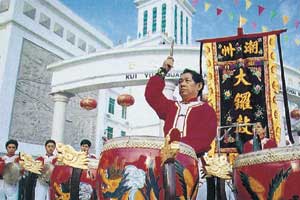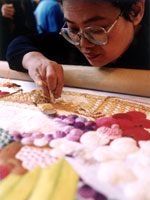Not many years ago, if one dropped by the winding streets of Chaozhou, a
medium-sized city in the east of South China's Guangdong Province, they would
probably notice an unique scene.
In the early morning, many local residents got up early and waited in long
queues outside restaurants.

Chaozhou drum music represents traditional Chinese
percussion music. |
They all anticipated the arrival of the first pot of beef meatball, a famous
local cuisine.
The local chefs only choose the finest beef and beat it into beef paste with
an iron stick. The result is an especially tenacious and tasty meatball, which
some people say could bounce on the ground higher than a ping pong ball.
It is a firm local belief that the first batch of beef meatball in the
morning always commands the best taste, and the clear soup without any traces of
oil is certainly beyond any description.
Although the mouthwatering image of the dish might jump into some gourmets'
mind immediately when Chaozhou is mentioned, the city that has 1,600 years of
history actually holds much more fascination than just this culinary oddity.
The city has been an incubator of many successful overseas Chinese
entrepreneurs including the Hong Kong tycoon Li Ka-Shing.
It has a rich local folk culture, featuring not only local opera and music
but also the famous Chaozhou Gongfu Tea.
Proud of what Chaozhou has to offer, Luo Wenzhi, mayor of Chaozhou, earlier
this week urged people from outside Chaozhou to spend a couple of days here to
experience the unique local culture, at a tourism and culture festival held
during the National Day holiday.
He said tourists could start sampling Chaozhou culinary culture with the
breakfast - or the delicious dim sum of Chaozhou. The suggested menu includes of
course beef meatballs and also fish meatballs, pork meatballs, Chaozhou rice
noodles and Chaozhou congee.
History tour

Chaozhou's embroidery is known as one of the four famous
Chinese embroidery styles. |
With enough
calories and fond memories, tourists can then embark on a journey of the local
historical sites.
The city has named more than 700 relic spots, among which the Guangji Bridge
(also named Xiangzi Bridge), the Imperial Son-in-law Xu's Mansion, Kaiyuan
Temple, Huang Konglue Temple, Song Kiln Relics, the Han Yu Memorial, and the
Hakka earthen building complexes.
The Guangji Bridge, built 800-odd years ago, consists of one leg of stone
plate bridge, one leg of arch bridge and one leg of floating bridge connected
with 18 boats. The leg of a floating bridge of 18 boats can be disconnected for
the passage of big boats, making it one of the world's earliest bridges capable
of opening and closing for the big boats passing by.
The 24 pavilions of different styles add glamour to this ancient bridge.
At the Imperial Son-in-law Xu's Mansion, tourists can have a close look at
the typical architectural pattern of the Song Dynasty (960-1279).
The quintessence of the architectural art, woodcut art of the dynasties of
Tang (AD 618-907), Song, Yuan (1279-1368), Ming (1368-1644) and Qing (1644-1911)
can be seen at the Kaiyuan Temple.
With a history of more than 1,200 years, the Kaiyuan Temple is a Buddhist
centre in the east of Guangdong.
The carving art masterpieces of Chaozhou in the Qing Dynasty are equally well
showcased at the Huang Konglue Temple.
Upon first glimpse, the wood carvings in Chaozhou are much brighter and
bolder in colouring than their counterparts in northern China. Looking closer,
one will observe even more complicated structures, with motifs of auspicious
animals, flowers and figures decorated everywhere possible.
The Song Kiln Relics, over 2 kilometres long, records the production and the
exquisite craftsmanship of ceramics in ancient Chaozhou.
The Han Yu Memorial was set up in honour of the great man of letters (AD
768-824), who was deported to Chaozhou in 819 during the Tang Dynasty.
Row upon row of inscribed boards hung from the beams of the first hall
eulogizing Han's great deeds.
Though governing Chaozhou for only eight months, Han did a lot to improve the
life of the Chaozhou natives.
The mountain where the memorial resides and the river it faces were later
named after Han Yu as a way of showing the local people's great gratitude.
The 500-year-old Daoyun Building, about 40 kilometres away for downtown
Chaozhou in its subordinate county of Raoping, represents a masterpiece of the
700 Hakka earthen building complexes in the city.
The Daoyun Building, built in the eight-trigram battle array, is one of
China's biggest Hakka earthen buildings.

